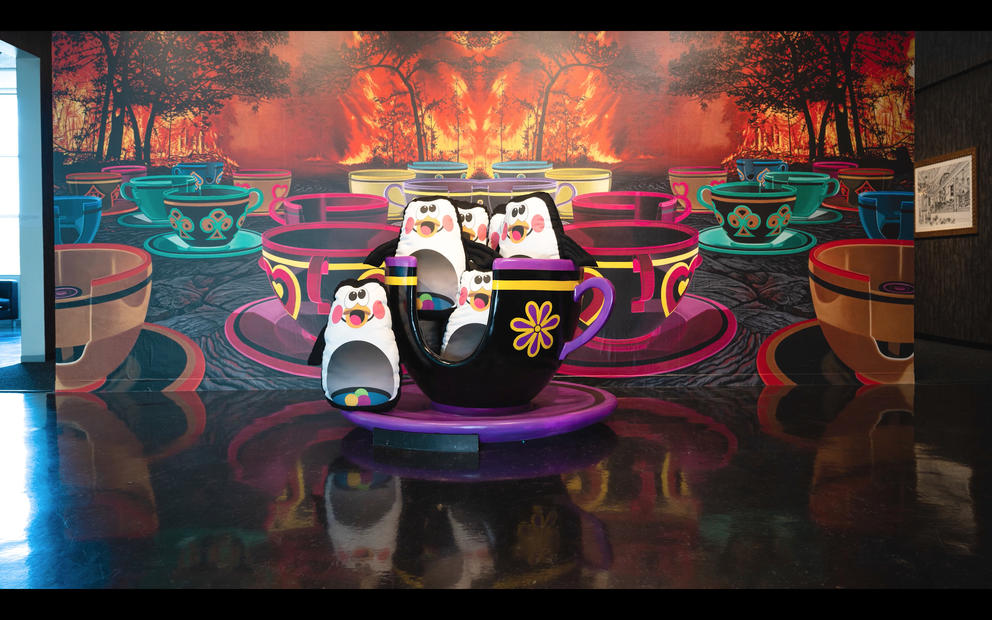But let’s get to the penguins. The reason scientists are newly pondering life on Venus is because of something discovered in the planet’s thick cloud cover, a “biosignature gas” called phosphine, which is also found a hop, skip and a planet away on Earth — in human intestines, deep sea worms and the feces of badgers and penguins. That’s quite a club.
And while this is may be a lot of science for an arts newsletter, I would argue that the Venus discovery is cultural, in the vein of Carl Sagan’s assertion that we’re all “made of star stuff.” The mystifying connections across our vast universe contribute to the culture we humans create, even if subconsciously, or via some microscopic cellular nudge.
Take, for example, the fact that during the coronavirus shutdowns, people have been taking penguins to art museums. Peruvian penguins from the Kansas City Zoo toured the empty Nelson-Atkins Museum of Art (allegedly preferring Caravaggio over Monet). And two Magellanic penguins from Shedd Aquarium in Chicago recently took in the city’s Museum of Contemporary Art.
While the Woodland Park Zoo penguins have so far stayed on the premises, the Bellevue Arts Museum (which reopens Oct. 2) just released its own clever take on penguin art walks. In a stop-motion video, the stuffed toy penguins from Nicole Gordon’s Altered States installation waddle around her apocalyptic artwork and crowd into an oversized teacup sitting in front of a fiery (you guessed it) hellscape.
Altered States was one of the many art shows interrupted by pandemic safety measures. But since Gov. Jay Inslee gave the go sign last month, local museums of all kinds have started to shake out the wrinkles and prepare to welcome visitors. While some museums may require a couple months before opening doors, none seems to be following the Zen path of the Noguchi Museum in Long Island City, New York, where the curator reports the temporarily closed space embodies an existence entirely separate from visitors and “has no more interest in you than the ocean does.”
The Cascadia Art Museum in Edmonds has an interest in you returning, and is reopening to the public (Sept. 23) with several intriguing new exhibits highlighting work by midcentury Northwest artists. On view is a collection of work by celebrated regional artist Leo Kenney, whose abstract, geometrical paintings resemble color studies of solar systems and space flotsam.
Also in the mix: “Quiet Motion and Blue,” by Seattle-born John Matsudaira, who after being incarcerated at Camp Minidoka in 1941, returned to the city, went to art school and started hanging out with artists like Paul Horiuchi and George Tsutakawa. Featured at the Seattle World’s Fair in 1962, this painting seems eerily relevant right now — recalling our strange yellow air, our gasping for a glimpse of blue.
The Burke Museum is also reopening next week (Sept. 22). The latest installation is a new fossil — a marine vertebrate resembling a shark, frozen mid-twist in a rock swirling with color. I love the look of this ancient creature, which lived during the Permian period some 250 million years ago, when Earth experienced its largest mass extinction and the planet was forever changed.
That sharklike fossil has me thinking about what we can absorb from the creatures that have found their own ways of existing on this rock. Everyone in my orbit is talking about the new Netflix documentary, My Octopus Teacher — and how the surprising relationship of a man and a cephalopod reveals how much we still have to learn. Documentarian Craig Foster says he first started free diving at South Africa’s frigid Cape of Storms to shake loose a creative block. Which, given the stunning result, is a pretty strong argument for leaning into the unknown.
You might not be ready to dive into Puget Sound and befriend a giant Pacific octopus, but what about taking an art class to get out of a rut? Seattle’s art education organizations offer many ways to flex your creative muscles — and they could use your help to stay afloat. The silver lining of this gray online existence is that you don’t have to slog through rush-hour traffic to get to a class or circle for parking once you arrive.
Hugo House has its customary slate of intriguing writing classes — from poetry to memoir to a special session on how to write about the state of the union, such as it is. Freehold encourages you to act now, with an array of theater classes, including playwriting, acting and improvisation. You can learn to hip-hop dance at Velocity Dance Center, and how to craft wire sculptures and jewelry at Pratt Fine Arts Center. Build a bouquet of clay flowers at Pottery Northwest, or learn how to make animated film loops at the Northwest Film Forum.
If communing with penguins and cephalopods has inspired you to ditch the job and become a full-time artist, check out the Studio Arts Intensive program at Gage Academy of Art, a yearlong series of drawing, painting and color theory classes taught by established teaching artists, including Klara Glosova and Whiting Tennis.
Or explore a new skill with an independent artist — such as Seattle’s Mandy Greer. Known for her otherworldly fabric installations, she’s translated her large-scale art form into approachable classes: modern tapestry weaving, which she teaches in person, socially distanced, in her backyard. Something about pushing and pulling dyed wool through a loom is highly appealing to me right now: connecting to an ancient craft, sparking new neural pathways, escaping to a world of your own making.
Get the latest in local arts and culture
This weekly newsletter brings arts news and cultural events straight to your inbox.









